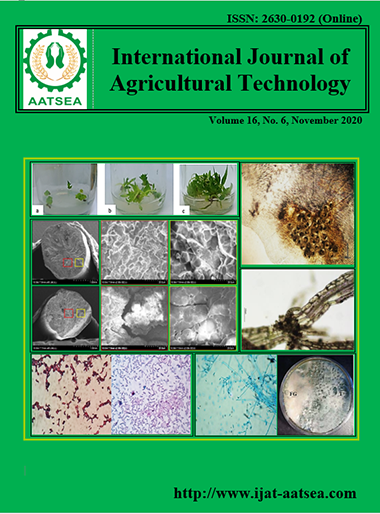Synergistic effect of some probiotics and natural dye on the improvement of yogurt properties
Main Article Content
Abstract
Probiotics play an important role to improve yogurt characteristics and increase its health benefits properties. The effects of adding micro-encapsulated Lactobacillus sp. and Streptococcus to yogurt in addition to natural dye obtained from (Morus rubra) were investigated. The micro-encapsulated Lactobacillus sp. and Streptococcus sp. were added to yogurt and natural dye to determine antioxidant activity, acidity, protein content and viscosity. The results showed that the use of micro-encapsulated Lactobacillus caseiLC12, Lactobacillus acidophilus LA5 and Lactobacillus rhamnosus LR22 remarkably maintained and increased the antioxidant activity as well as they decreased the undesired changes in yogurt properties involving acidity, protein content, syneresis and viscosity compared to the use of non-encapsulated strains. The data indicated that the use of Streptococcus improved yogurt characteristics which significantly lower than Lactobacillus sp. Finally, the addition of probiotics were accompanied by natural dye to yogurt remarkably increasing the beneficial healthy properties on antioxidant, acidity, protein content and viscosity. It is indicated that the priority using Lactobacillus sp. was better than Streptococcus sp.
Article Details

This work is licensed under a Creative Commons Attribution-NonCommercial-NoDerivatives 4.0 International License.
References
Akar, Z, Küçük, M. and Doğan, H. (2017). A new colorimetric DPPH scavenging activity method with no need for a spectrophotometer applied on synthetic and natural antioxidants and medicinal herbs. Journal of Enzyme Inhibition and Medicinal Chemistry, 32:640-647.
Amatayakul, T., Sherkat, F. and Shah, N. P. (2006). Syneresis in set yogurt as affected by EPS starter cultures and levels of solids. International Journal of Dairy Technology, 59:216-221.
Barbano, D., Lynch, J. and Fleming, J. R. (1991). Direct and indirect determination of true protein content of milk by Kjeldahl analysis: collaborative study. Journal-Association of official analytical chemists, 74:281-288.
Brewer, M. S. (2011). Natural antioxidants: sources, compounds, mechanisms of action, and potential applications. Comprehensive reviews in food science and food safety, 10:221-247.
Chen, J., Lindmark-Månsson, H., Gorton, L. and Åkesson, B. (2003). Antioxidant capacity of bovine milk as assayed by spectrophotometric and amperometric methods. International Dairy Journal, 13:927-935.
Da Silva, I. P., Brissow, E., KellnerFilho, L. C., Senabio, J., de Siqueira, K. A., Vandresen Filho, S. and Junior, P. A. S. (2017). Bioactive compounds of Aspergillus terreus—F7, an endophytic fungus from Hyptissuaveolens (L.) Poit. World Journal of Microbiology and Biotechnology, 33:62.
Darias-Martín, J., Lobo-Rodrigo, G., Hernández-Cordero, J., Díaz-Díaz, E. and Díaz-Romero, C. (2003). Alcoholic beverages obtained from black mulberry. Food Technol. Biotechnol, 41:173-176.
Dave, R. and Shah, N. (1996). Evaluation of media for selective enumeration of Streptococcus thermophilus, Lactobacillus delbrueckiisp. bulgaricus, Lactobacillus acidophilus, and bifidobacteria. Journal of Dairy Science, 79:1529-1536.
Elmaci, Y. and Tomris, Y. T. (2002). Flavour evaluation of three black mulberry (Morus nigra) cultivars using GC/MS, chemical and sensory data. Journal of the Science of Food and Agriculture, 82:632-635.
Gustaw, W., Szwajgier, D. and Mleko, S. (2009). The rheological properties of yoghurt with the addition of lyophilized polymerized whey protein. Milchwissenschaft, 64:60.
Gustaw, W., Glibowski, P. and Mleko. S. (2006). The rheological properties of yoghurt with incorporated whey protein aggregates/polymers. Milchwissenschaft-Milk Science International, 61:415-418.
Lieberman, J., Goff, D., Hammond, F., Schreiner, P., Norton, H. J., Dulin, M., Zhou, X. and Steffen, L. (2014). Dietary intake and adherence to the 2010 Dietary Guidelines for Americans among individuals with chronic spinal cord injury: a pilot study. The journal of spinal cord medicine, 37:751-757.
Maganha, L. C., Rosim, R. E., Corassin, C. H., Cruz, A. G., Faria, J. A. and Oliveira, C. A. (2014). Viability of probiotic bacteria in fermented skim milk produced with different levels of milk powder and sugar. International Journal of Dairy Technology, 67:89-94.
Martini, M. C., Kukielka, D. and Savaiano, D. A. (1991). Lactose digestion from yogurt: influence of a meal and additional lactose. The American journal of clinical nutrition, 53:1253-1258.
Mena-Chalas, B. J. (2013). Influence of “Added” Lactose on Probiotic Properties of Yogurt Culture Bacteria and Yogurt Characteristics. (Master thesis). Faculty of the Louisiana State University and Agricultural and Mechanical College.
Naderi, G. A., Asgary, S., Sarraf-Zadegan, N., Oroojy, H. and Afshin- Nia, F. (2004). Antioxidant activity of three extracts of Morus nigra. Phytother Research, 18:365-369.
Saez-Lara, M. J., Gomez-Llorente, C., Plaza-Diaz, J. and Gil, A. (2015). The role of probiotic lactic acid bacteria and bifidobacteria in the prevention and treatment of inflammatory bowel disease and other related diseases: a systematic review of randomized human clinical trials. Biomed research international, 2015: 505878.
Samona, A. and Robinson, R. (1994). Effect of yogurt cultures on the survival of bifidobacteria in fermented milks. International Journal of Dairy Technology, 47:58-60.
Schmidt, K. and Bledsoe, K. (1995). Effects of homogenization pressure on physical and sensory characteristics of low fat yogurt. Cultured Dairy Products Journal, 22:34-140.
Shah, N. P. (2007). Functional cultures and health benefits. The International Dairy Journal, 17:1262-77.
Suh, H. J., Noh, D. O., Kang, C. S., Kim, J. M. and Lee, S. W. (2003). Thermal kinetics of color degradation of mulberry fruit extract. Nahrung/Food, 47:132-135.
Tsai, P. J., Huang, H. P. and Huang, T. C. (2004). Relationship between anthocyanin patterns and antioxidant capacity in mulberry wine during storage. Journal of Food Quality, 27:497-505.
Yoo, J. Y. and Kim, S. S. (2016). Probiotics and prebiotics: Present status and future perspectives on metabolic disorders. Nutrients, 8:173.
Zainoldin, K. and Baba, A. (2009). The effect of Hylocereuspolyrhizus and Hylocereusundatus on physicochemical, proteolysis, and antioxidant activity in yogurt. World Academy of Science, Engineering and Technology, 60:361-366.
Zhao, G. R., Xiang, Z. J., Ye, T. X., Yaun, J. Y. and Guo, X. Z. (2006) Antioxidant activities of Salvia miltiorrhiza and Panaxnotoginseng. Food Chemistry, 99:767-774.


